|
FAQs about "Freshwater" Morays Eels
3
Related FAQs:
FW Morays 1,
FW Morays 2,
FW Morays 4, FW Morays 5,
FW Morays 6,
FW Moray ID,
FW Moray Behavior,
FW Moray Compatibility,
FW Moray Selection,
FW Moray Systems,
FW Moray Feeding,
FW Moray Disease,
FW Moray Reproduction,
Marine Moray
Eels,
Related Articles:
Freshwater Moray Eels by Marco Lichtenberger,
Freshwater Moray Eels by Bob Fenner,
Moray Eels, Other Marine Eels,
|
|
|
Re: And now I have three of them! (RMF, am I quoting you right here?)
12/1/17
>>Clown Loaches in brackish water? Not I, though am back to Borneo in
January...<<
Hello Neale and all you wonderful people at WetWebMedia, warm greetings from
Indonesia!
<Definitely more pleasant than cold, dark, wet wintertime England!>
As promised, here are further observation from my aquarium. I have good news.
Now I have three Echidna rhodochilus. I found a guy who caught two Echidnas from
Segara Anakan lake, South Java. This is very far from the original place of my
first echidna, which was Muaratawar estuarium in North Bekasi, at the northern
part of Java. They are bigger than my older Echidna, maybe about 40cms, and
fatter too.
<Very nice additions, in my opinion. I am most envious of your relatively easy
access to such a variety of fish-life.>
He put them in freshwater aquarium for many months, together with an Oscar.
They got along well, and indeed they are just as docile as my previous Echidna
at home. But knowing how Oscars are, what's stopping the Oscar to consider those
much smaller Echidnas as tasty worms? So therefore I bought
them all. I named them Emerson and Wakeman :D
<Nice!>
So, I put them on my aquarium, and indeed, they get along well with each other,
and with my older Echidna. They even share the same home pipes.
<This/these species are often sociable. Not 100% reliable, but oftentimes.>
After a few days there are no fighting for space or for food (I have plenty of
feeder guppies and river shrimps still in the tank). Mr. Echidna (the first
moray) and Emerson are very active, they like to dig the sand and rearrange the
pipes and other ornaments. while Wakeman seems to be content on sitting on its
pipe, going out only when wanting to terrorize the shrimps and guppies. It's
humorous to see Echidna and Emerson digging under the pipe where Wakeman is in,
as both his friends are busy digging, Wakeman stuck his head out of the pipe, as
if saying "Yo guys, what's going on??".
BTW, you are very correct, echidna rhodochilus are not as "fierce" as the
reputation of morays in general public tends to portray them. They never made
any attempt to bite me, not even the new ones. When I put my hand on
the aquarium, they just slip around and under my fingers as if swimming around
mangrove roots. They seems to have a high "Curiosity" as you said.
<That is very much true for Morays. Altogether lovely fish, and excellent
aquarium residents.>
For experiment, I put some Yoyo loaches and clown loaches. All three echidnas
doesn't seem to mind, they don't even react when the loaches are entering their
pipes. Therefore, these echidnas that I have doesn't seem to
exhibit any territorial aggression, at least for now.
<Interesting.>
My question: The loaches seems to be doing well, they are still as colorful and
as playful as ever, so maybe the different salinity level in my echidna aquarium
are not significant enough for them. Or maybe loaches does have a
bit of tolerance for low-end brackish? I will move them back to my other
aquarium sometime later, but if they seems to be happy with the morays, shall I
left them alone, or must I move them back?
<Good question. Generally, loaches are not brackish water. But Fishbase reports
Acantopsis choirorhynchos as occurring in brackish water, and there are reports
of Clowns in brackish, but I'm very skeptical of this -- though
I know Bob Fenner has mentioned seeing this in the wild, I believe. Still, the
loach/moray combo isn't one I'd particularly recommend, and if you see signs of
stress, I'd be rehoming one/other of the species accordingly.>
My second question: I am still unsuccessful in weaning my echidna (the old one)
away from live shrimps and guppies. It doesn't seem to be interested with frozen
shrimps and bloodworms for now. Maybe because there are still some live shrimps
and guppies left in the aquarium from the last batch I bought. What are your
thoughts about this?
<These Morays do hunt by smell. Try using long forceps or bamboo satay skewers
to offer small bits of meat near visibly hungry Morays. Feel free to starve 'em
for a week or more if needed! They will, when hungry, snap at
food offered in this way. Do let me direct you to some reading, here:
http://www.wetwebmedia.com/morayfdgfaqs.htm
While aimed at marine Morays, much the same holds for their freshwater
relatives.>
Well, that would be all for now, thank you for your kind attention!
Best Regards, Ben
<And to you, Ben; cheers, Neale.>
|
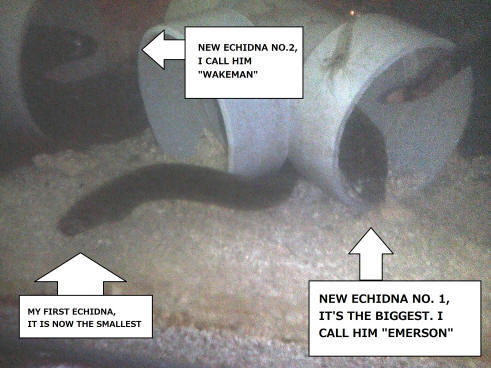
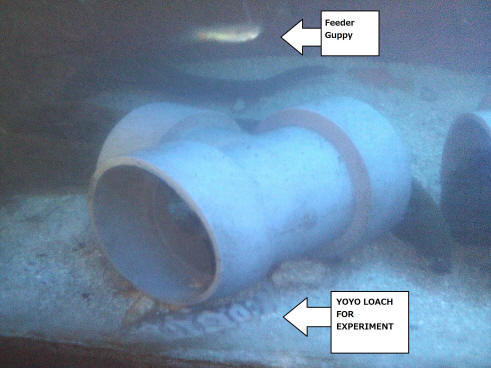
|
Re: And now I have three of them!
12/2/17
Hello Neale and all you amazing people at WetWebMedia, warm greetings from
Jakarta, Indonesia, we hope your weekend will be very enjoyable!
<Well, actually rather busy with furniture being moved out of storage -- but
let's hope for a successful weekend, anyway.>
Following up our previous conversation about Echidna Rhodochilus and loaches,
here are more pictures from my "experiment".
<Indeed.>
As I mentioned, the Yoyo loaches and the Clown loaches seems to get along with
the morays; the clowns in particular seems to take an interest in the largest
moray (Mr. Emerson), they swims around him and even "resting" their bodies on
him when he is visiting the bogwood ornament which I put in a corner of the
aquarium. The Yoyo loaches are moving in and out of the morays' home-pipe with
no fear and not molested at all. I include the
pictures with this e-mail.
<Neat! While I remain skeptical about the loach/moray combination in the long
term, it might well be that you can find a 'happy medium' salinity that suits
them both. Certainly such things happen in the wild, at the very edges of
estuaries, where freshwater and euryhaline brackish water fish coexist, often in
huge numbers. My own local river, the River Thames, as it rolls through London
is just such a habitat, mixing freshwater bream and
roach alongside brackish water flounders and eels.>
All loaches so far still retain their colors and cheerful behavior, and still
eats like pigs whenever I throw bloodworms at them. No negative impact from the
brackish water are seen yet.
<Good.>
No physical changes seen yet. I think I will continue the experiment for a week
to see if any negative effects appeared. If any negative effects are showing, I
will certainly follow your advice & return the loaches to their
previous (full FW) home.
<Wise.>
The only "bad sign" I observed, is that the guppies, shrimp and Sailfin mollies
that I intend to be put as "feeder fishes" (for the echidnas), often get to the
bloodworms intended for the loaches FASTER than the loaches themselves. They
have this incredible speed and intuition; loaches seems to swims slowly and
lazily towards the bloodworms, while mollies, guppies and shrimps moves very
fast. Luckily, they seems to only able to take small bits and pieces, while the
loaches eats the larger portions.
<Try feeding at night, maybe once or twice a week. Catfish pellets or wafers
will be slowly nibbled on by loaches through the night, when the Mollies are
asleep.>
Thank you for the feeding tips; I will wait until the morays has consumed all
the feeder guppies and shrimps, before trying to put them into "fasting mode".
With the exception of largest few shrimps which came from the first
batch of shrimps, that I put in this aquarium months ago... they seemed to have
become "part of the landscape" instead of being "feeders", as the morays doesn't
seems to molest them at all, even though they will terrorize
and eat the smaller shrimps from newer batches.
<Odd!>
A friend told me that a feeder who survived several weeks without being caught,
will have its smell "blended" with the environment, and thus the bigger fishes
cannot smell them anymore. Is this true?
<It's certainly plausible.>
Lastly, I am thinking of writing a small article about my experiences keeping
the Echidnas. It will be a summary of our discussions here and other info which
I gathered both from the Internet and from personal experiences. I hope that
article will be useful for all FW moray lovers worldwide. What are your thoughts
about this one? As you mentioned, I do have relatively easy access to fishes
that are considered "rare" in the rest of the world, so I wish to share my
experiences with them.
<Anywhere in mind? TFH in the US and PFK in the UK are two of the best known,
but might also think about the likes of Amazonas, a magazine more tailored to
advanced hobbyists worldwide, with a particular accent on top-quality
photography. They've certainly published many lovely articles on wild-caught
species including photos of their natural habitat, capture methods, and so on.
Sounds up your street, I'd have thought!>
Well, again I thank you and have a nice weekend!
<Good luck with the article, Neale.>
|
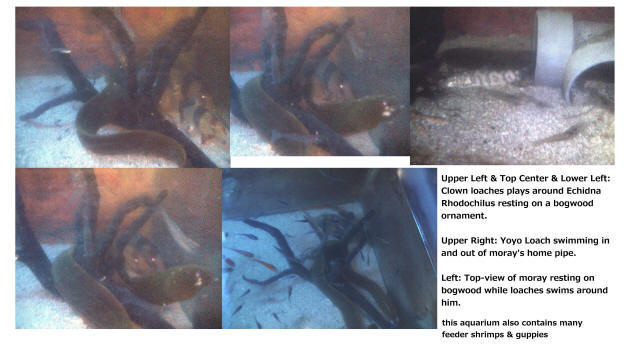 |
Re: And now I have three of them!
12/4/17
Hello Neale and all you excellent people at WetWebMedia. Greeting from
Jakarta!
<Hello Ben,>
(Neale, I hope your furniture-moving experience last week were enjoyable!)
<Wouldn't say 'enjoyable' as such...>
Thank you for your input about my future article. For now, my
English-language capabilities are still not so adequate for serious articles
in prominent magazines. I need to brush-up my skills first & obtain more
knowledge, before attempting to write such serious articles. Again thank you
for your suggestions & I will make that on top of my "List of Important
Things to Do".
<Hmm... do write to Bob Fenner at this website. He knows much more about the
trade than I do.>
Since I am in creative mood, I start by writing my thoughts about FW Morays
on my personal website here:
https://sites.google.com/site/houseofharyo/freshwater-moray-page
<Ah, yes! I do think self publishing is a good way to develop your writing
skills.>
If you are not busy, please have a look! Your comments and inputs will be
very much appreciated! * bowing *
<Have looked, and enjoyed. Would point out "Mr. Bob" is "Bob Fenner", and
"Mr. Marco" is "Dr. Marco Lichtenberger".>
This is a work in progress, and will be updated & expanded in the future,
when I finally get my hands on a G. Polyuranodon and possibly G. Tile.
<Quite so.>
I was contacted by another hobbyist (the one who sold me my first Echidna
R.), that he has access to a shop where they know what a Hydrometer are &
possibly has some in stock. If I can actually get my hands on one, I will
do salinity testing on my aquarium, as I am very much interested to know
what the numbers are. Then I will do testing on the river near me and the
other one in North Bekasi (where they caught my first Echidna Rhodochilus).
This way I can draw a salinity chart, which might be useful.
<Absolutely. I'd have thought a magazine or commercial website would enjoy
an article written about 'freshwater' Morays in the wild, with details of
their actual environment. One problem the hobby has is when aquarists repeat
facts from other aquarists. Sometimes those facts are false, but so embedded
in the literature (books, magazines, and now websites) those facts are
treated like Gospel! So actually going out to a 'freshwater' Moray habitat,
measuring the pH and salinity, and then writing those numbers down is
EXACTLY how the hobby moves forwards. Include some nice sharp photos of the
habitats, as well as nice sharp photos of your Morays, and I'd think you'd
be on your way to a very commercially sellable article!>
Well, that would be all for now. I wish you a wonderful day & will keep you
updated.
Best Regards, Ben
<Cheers, Neale.>
|
Re: And now I have three of them!
12/14/17
Hello Neale and all of you splendid people at WetWebMedia. Greetings from
Jakarta!
<And to you, greetings from Berkhamsted, England!>
Thank you for your good info about articles, they are very inspiring. I will
plan my research and the trips accordingly. I hope I will be able to find the
time after the Asian Games.
<Oh!>
Through Facebook, I met a new friend online from Yogyakarta (a neighboring
province). He is a fish seller who specializes in FW morays, sourced locally
from rivers in southern part of Java. In fact he kept Strophidon
Sathetes on large FW aquarium for months, as well as other "FW" moray types.
They said that the longest time he had experienced in keeping G. Tile, E.
Rhodochilus and G. Polyuranodon in "freshwater" (freshwater with a
little amount of seawater mixed in) were 2-3 years before those are being sold.
He even mentioned that he once had a white-mouth moray in FW for a few months
before someone bought it from him. This city will be on my list
of "places to visit" in my quest for getting more understanding about FW moray
eels.
<Indeed! This sounds like what'll be a great trip. So many interesting things to
learn about freshwater Morays, and you're lucky enough to be able to find out
about them in the wild.>
As for my clown loaches, they're still being good friends with the eels, sharing
their home pipes in peace. I think they looks so cute together, so I will keep
the loaches there for a bit longer. The loaches looks fat and
healthy, and so far still colorful. They often use the long bodies of the eels
as "pillows" to "sleep", ha! But again I am very aware that the water I am
putting them now is not their usual habitat. With that in mind, what are the
sign of "salinity too high" for loaches? Does this include losing their bright
colors?
<Possibly. But more likely they'll become skittish, nervous, disinterested in
food.>
One thing I noticed is that Mr. Emerson (my largest moray) has been moving this
home pipes around a lot these past few days. He dug the sand in and out under
the pipes, moving the pipes from one corner of the aquarium to
another. So I guess he must be hungry but getting bored with the live river
shrimps and the feeder guppies & mollies.
<Does seem possible. A variety of foods are always a good idea, to round out any
vitamin shortcomings in the foods you've used so far. Squid, white fish like
tilapia, and clams all good options.>
And to think about it, the river shrimps on my aquarium has grown a bit, they're
eating well (they seems to love to eat the leftover body parts of their fallen
comrades, or even their moulting friends),
<Normal. Recycling calcium. They're meant to do this!>
and has become rather large, with long menacing pincers. So, not so appealing
anymore for the eels (I think, do I make sense? What do you think dear Neale? I
think those shrimps are Macrobrachium types).
<Many shrimps have larger front claws, so in itself not definitely
Macrobrachium. But on the other hand, Macrobrachium are so widely farmed in Asia
that the odds of them ending up in the aquarium trade is high. I've
even seen them here in England, though the demand for them is not great.
Not alive, anyway! Very delicious when cooked!!!>
So just a few hours ago, I cut up a large, thawed frozen shrimp and threw it to
the aquarium, experimenting, maybe the largest moray would eat it.
And yes, Mr. Emerson opened his jaws very widely and ate the pieces of frozen
shrimp in the manner of a snake. It's very interesting to see how snake-like he
is when eating. And it was humorous to see him sniffing
around confusedly trying to find the rest of the pieces, right after the river
shrimps literally stole the pieces from under his nose, ha! My friends told me
that morays are blind as a bat, they only have the sense of smell and the sense
of movement (they could detect movements). After seeing how easy it is for
shrimps to steal food from under a moray's nose, I believe it.
<Spot on. Indeed, they can be "blinded" by too much smelly food in the tank at
once. Like a bright light blinding a person, I guess, making it hard to see
things.>
The other two, Mr. Wakeman (the second largest moray) and Mr. Echidna (the
smallest, my first moray) doesn't seem to be interested in frozen shrimps for
now. I hope they will follow suit soon.
<Quite so. Plus, do offer some white fish as well as molluscs, like clams.
The more variety, the better.>
Well, that's my latest updates for now. Thank you for following my fish stories
and being such a good listener. Have a nice day!
<And you too. Cheers, Neale.>
|
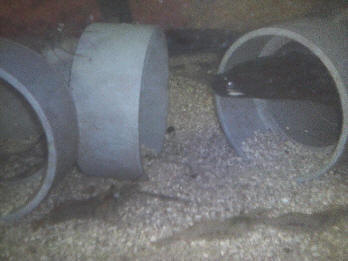
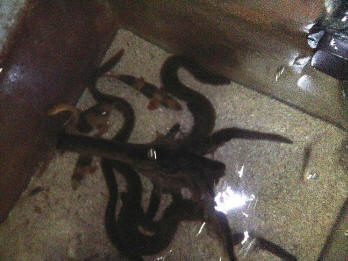 |
|
Various types of Morays that are usually caught in the rivers in
Indonesia 12/20/17
Good evening Neale and all of you beautiful people at WetWebMedia.
Greetings from Jakarta!
<And a howdy to you too, Ben.>
(Neale, your hometown "Berkhamsted", from the name, which sounds archaic, I
assume this is a very old historic town with a castle surrounded by moats.
Must be a wonderful tourist attraction!)
<Well, it's quite pretty I suppose. But it's home!>
I'd like to present some of the pictures from Mr. Septian, my friend in
Yogyakarta, Indonesia, who specializes in capturing and selling moray eels from
the rivers in that province, to ornamental fish lovers. He had sold them all,
but he still has many in stock.
As you can see, he routinely captured the usual suspects of G. Polyuranodons and
G. Tiles, but he also had captured some not-so-usual morays in the past, such as
Strophidon sathetes, G. Undulatus, and some others I cannot recognize. All were
caught in the river, not far from the estuarium, just a few kilometers.
Interesting eh? Make me even more interested to go there and sample the water!
<Oh, absolutely! One thing to remember though is vertical stratification is VERY
common in estuaries. In other words, dense seawater moves along the bottom of
the estuary, like a wedge. Less dense freshwater floats on top.
https://en.wikipedia.org/wiki/Estuarine_water_circulation
So you will find freshwater fish in the top few metres, but marine fish at the
bottom, and for all practical purposes the two kinds of environment don't mix.
Some fish can of course swim between salt and freshwater -- many
puffers for example -- while others stick very much to their preferred salinity.
So even if a river estuary is several km inland, the bottom could easily be
almost fully marine conditions, whereas the top few metres might be more or less
completely freshwater. Strong currents (such as upwelling) can cause mixing, but
if the river is slow and ambling gently towards the sea, there might be very
little mixing. This means that if you dip your hydrometer into the water next to
the riverbank, you might detect a very low salinity; but if you put a baited
trap on the bottom to catch fish living there, you might be catching fish from
the salty, near-marine environment at the bottom.>
As for my own eels, I will try to feed my eels again tonight with frozen shrimps
and squids. Mr. Emerson (the largest) loves frozen shrimps now, but the other
two are still not interested. If they reject the squids, I will
make myself fried calamari for dessert ;)
<Yum!>
Thank you and have a nice day!
Best regards,
Ben
<And to you, best wishes, Neale.>
|
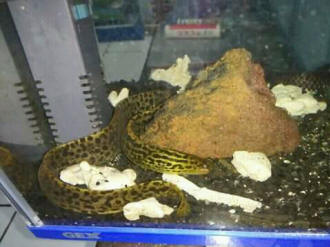
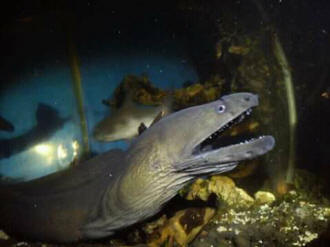
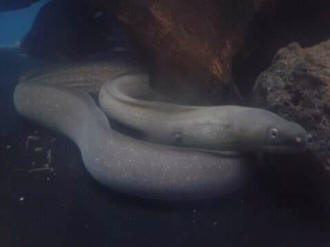
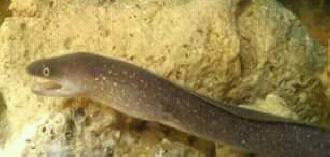
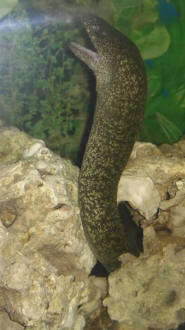
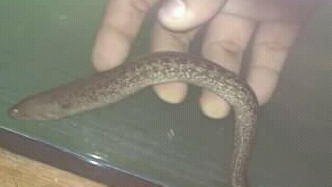
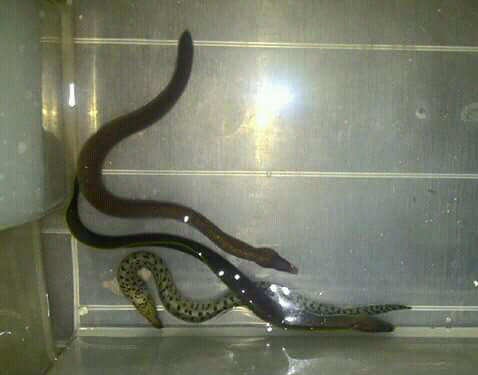 |
Re: fw: Various types of Morays that are usually
caught in the rivers in Indonesia 12/21/17
Marco; thought you'd find this message/post interesting. BobF
Thanks. Indeed is!
<Cheers mate. B>
Various types of Morays that are usually caught in the rivers in Indonesia
/Marco 12/21/17
Good evening Neale and all of you beautiful people at WetWebMedia.
Greetings from Jakarta!
<Hi Ben.>
(Neale, your hometown "Berkhamsted", from the name, which sounds archaic, I
assume this is a very old historic town with a castle surrounded by moats.
Must be a wonderful tourist attraction!)
I'd like to present some of the pictures from Mr. Septian, my friend in
Yogyakarta, Indonesia, who specializes in capturing and selling moray eels
from the rivers in that province, to ornamental fish lovers. He had sold
them all, but he still has many in stock.
As you can see, he routinely captured the usual suspects of G. Polyuranodons
and G. tiles, but he also had captured some not-so-usual morays in the past,
such as Strophidon sathetes, G. undulatus, and some others I cannot
recognize. All were caught in the river, not far from the estuarium, just a
few kilometers. Interesting eh? Make me even more
interested to go there and sample the water!
<Indeed. Especially the S. sathete looks amazing! Most common in estuaries
and can grow well beyond 3 m. I can also see Gymnothorax richardsonii (known
as the dish "Bakasi" around the city of Cordova on Cebu) and Gymnothorax
fimbriatus in the pictures you sent. All of the above have been reported
from brackish waters, even G. fimbriatus. Can't see G. undulatus in the
pictures, but it's reported from brackish waters, too, so it's well
possible.>
As for my own eels, I will try to feed my eels again tonight with frozen
shrimps and squids. Mr. Emerson (the largest) loves frozen shrimps now, but
the other two are still not interested. If they reject the squids, I will
make myself fried calamari for dessert.
<Kept G. polyuranodon in the past for many years. Various fish species were
the favourite food, but shrimps, clams and calamari were also eaten when
hungry.>
Thank you and have a nice day!
<You too.>
Best regards, Ben
<Cheers, Marco.>
Re: Various types of Morays that are usually caught in
the rivers in Indonesia 12/22/17
Hello Marco!
<Hello Ben.>
Thank you for replying & sharing the info about feeding your G. polyuranodon. I
am in the process of acquiring a G. polyuranodon. I hope they are easier to wean
off live food than my Echidna rhodochilus.
<Had no problem with either of them.>
To this day two of my three E. Rhodochilus still refuse to eat anything else but
live shrimps and feeder guppies/mollies. Especially the small one, it is very
picky about the size of its prey; it terrorized the smaller shrimps, but keep
away from the larger ones, especially the ones with long pincers :D
<A calm and dark environment without other fishes in my experience makes it more
easy to train morays to frozen food. Also, I'd start with the same food items
they eat alive. >
Maybe when there are no more feeder shrimps/fishes in the aquarium, they will
start looking for extra alternatives. My goal is to get them to eat bloodworms.
<Why would you want to do that? They are not part of their natural diet and not
very valuable as a food source for such a fish. I'd aim for a variety of
crustaceans and fish with addition of cephalopods and bivalves.>
One of my friend has been able to train his G. Polys to eat bloodworms, I think
it's very cool, I offered to buy one of his, but he is very reluctant to sell
his eels to me, so I must acquire a newly caught G. Poly of my own & begin
training.
Here is a video of his G. Polys, eating bloodworms.
https://www.youtube.com/watch?v=816Z5mD9NDs
<Poor eels.>
So, you ate morays (G. Richardsonii) during your trip to the Philippines?
Must have been an interesting experience, I imagine a fish that long must have
hundreds of long sharp bones, how does the cook handle that?
<See here in Manila:
http://www.marketmanila.com/archives/bakasi-a-la-victor . The bones are
indeed a big downer.>
I read somewhere that Strophidon are frequently being caught in the
Gangga/Ganges river in India, and the locals regarded them as food-fish. I
imagine a 3 meters Strophidon could feed a small family!
<Morays are eaten all around the world. The Romans, who started fish keeping (in
Europe at least) also kept morays as a food source. Muraena helena still is
often eaten around the Mediterranean as are many species in the Pacific, e.g. in
Japan, China. The larger the eels, the higher the content of Ciguatoxins,
though.>
I hope one day we will be able to discover the reasons why some species of
marine morays has the tendency to enter brackish waters, even all the way to
freshwater, while most other morays remained in the sea and has nothing
to do with brackish and freshwater.
<Mostly to hunt (estuaries are rich in nutrients), some maybe to breed, but
little research has been conducted with regard to that.>
Well, thank you for the discussions! Best Regards, Ben
<Cheers, Marco.>
Re: Various types of Morays that are usually caught in the rivers in Indonesia
12/23/17
Hello Neale, and all of you amazing people at WetWebMedia,
<Hello again Ben!>
Thank you for informing me about the vertical stratification of salinity in
estuariums. I think I have heard of this occurring in Sentani Lake in Papua
province. Perhaps the same thing also happening in the rivers of Java, it
makes sense that a few kilometers away from the estuarium, the lower parts of
the rivers actually still a bit brackish. Morays are bottom dwellers, and
brackish bottoms of the rivers must have suited them well, which could
explain why our friends in Indonesia routinely caught them in such rivers.
<Quite so. Or not! As the case may be.>
I hope one day we will also be able to explain the causes of differences in
environmental preferences among the many species of brackish/"freshwater"
morays. As an example, G. Polyuranodons are routinely being caught far
inland, which means they enjoy being in FW environment, while G. Tiles are
routinely being caught in the river mouths, which are brackish water
environment, which means that they could enter FW but much prefer BW.
<Does seem about right.>
Maybe we will be able to explain the differences in behavior in captivity as
well, such as: Strophidon will bite, while E. Rhodochilus are more timid and
docile (at least mine are).
<Interesting. Definitely keep notes on what you discover, and the more photos
and facts you record, the better. Is there an aquarium society in your part of
the world? Perhaps give a presentation on what you learn, or write something for
their magazine. You might get some extra feedback that will help you expand your
knowledge even further.>
Well, thank you for the excellent discussions!
Best Regards,
Ben
<Cheers, Neale.>
|
Subject: Re: Various types of Morays that are usually caught in the
rivers in Indonesia 12/26/17
Hello Marco!
<Hi Ben.>
Thank you for your advice about FW moray feeding, I will put them into practice.
I intend to introduce my morays to a variety of food, from bloodworms to frozen
shrimps to tilapia fillets, in addition to live food as they have now. Certainly
I don't plan to feed them exclusively on bloodworms ;)
<Good to hear.>
Interesting to hear that morays are eaten around the world. I read up about the
ciguatera poisoning, sounds horrible. Luckily, I no longer eat fishes which has
no scales or no fins or both, thus all types of morays and eels, I don't eat,
thus I am save from the ciguatera (hopefully!).
<The accumulation of toxins has nothing to do with fish having scales or not. In
addition, almost all fishes, among them almost all eels and all morays, have
fins. For example, your morays have dorsal, caudal and anal fins that compose a
continuous seam. To avoid Ciguatera simply avoid eating large predatory
specimens. Most intoxications are related to barracudas and groupers (both have
scales and fins by the way).>
have a wonderful day!
<You, too. Cheers, Marco.>
Best Regards, Ben
Re: Various types of Morays that are usually caught in the rivers in Indonesia
12/26/17
Merry Christmas Neale and all you great people at WetWebMedia, greetings from
Indonesia!
<Hi Ben! Merry Christmas to you, too. Going to bounce the rest of this message
into Marco mailbox. Do feel he's much more of an expert on these obscure Moray
Eels than I am! Cheers, Neale.>
Re: Various types of Morays that are usually caught in the rivers in Indonesia
12/26/17
Merry Christmas Neale and all you great people at WetWebMedia, greetings from
Indonesia!
<Merry Christmas to you, too.>
Good news: I finally obtained a hydrometer. Through the directions given to me
by another moray fans, I am able to locate a fish shop which sells this
hydrometer. It is actually a new booth located in Sumenep, my usual
hangouts. This booth specializes in aquarium equipments imported from China.
Super cheap compared to Japanese or Western imports.
Bad news: The shop owner totally has no clue about what is a hydrometer and how
to use it. His excuse is: "I don't read Chinese, I don't understand English".
Worse news: the hydrometer itself is made in China, the instructions are written
in Chinese, and the English translation is confusing. But anyway, I hope i will
be able to figure out how to use it. I am happy I finally own one, and I will
start testing soon. I will let you know my findings when I am done sampling.
<It's easy. I use one of these too, when a more exact measurement is not
necessary. Fill it to the upper line with water und read at the tip of the
pointer on the scale you prefer. Left scale for ppt, right scale for SG.>
Thank you for your kind encouragement, I will certainly continue my research.
For now I think there are no scientific society of aquarists around here, what
we do have are hobbyists clubs, and I am now a member of
Indonesian freshwater morays fans club. However we're all beginner hobbyists and
none are expert aquarists trained in aquarium science, unlike you, Mr. Fenner
and Mr. Mario. What I will continue doing is to collect some more
specimens (I am aiming for at least one G. polyuranodon and maybe one small G.
tile), and making notes on their behavior & living environment. I will also
making notes on other morays I found in captivity around here.
<Sounds very interesting. Feel free to keep us updated.>
In fact, in Sumenep there is actually a guy who keep some morays, I include the
picture here. There is one echidna nebulosa that looks stressed & swimming
around so fast, darting around like crazy. Aren't morays supposed to stay
more-or-less stationary at the bottom?
<They spend most of their life in caves or buried in mud.>
Is this behavior due to being put in bare aquarium?
<Exactly. Pure stress. They need caves. I used at least two per eel even in
holding tanks when trading them.>
And there are some morays bunching up around the filter and some other under a
rock. Looks like honeycomb morays, or maybe tessellated morays? I am not so sure
and the shop owner does not understand Latin names.
<Honeycomb moray and tessellated moray are two common names used for the same
species: Gymnothorax favagineus. There might also be a closely related
Gymnothorax isingteena with jaguar-like spots in the center of the upper
picture.>
I think these morays are supposed to be 100% marine species, but perhaps our
marine morays population does prefer to hunt in the estuarium.
<G. favagineus is indeed found in brackish waters, but prefers marine
environments.>
Well, wish us luck & have a nice day!
<Thanks. Cheers, Marco.>
Best Regards, Ben
Re: Various types of Morays that are usually caught in the rivers in Indonesia
12/26/17
Hello again Marco,
<Hi Ben.>
Thank you for the information about Ciguatera poisoning. Now I know better which
fishes to avoid. Glad to hear that it's not about fins and scales!
Best Regards, Ben
<Very good. Take care. Marco.>
|
|
|
|

